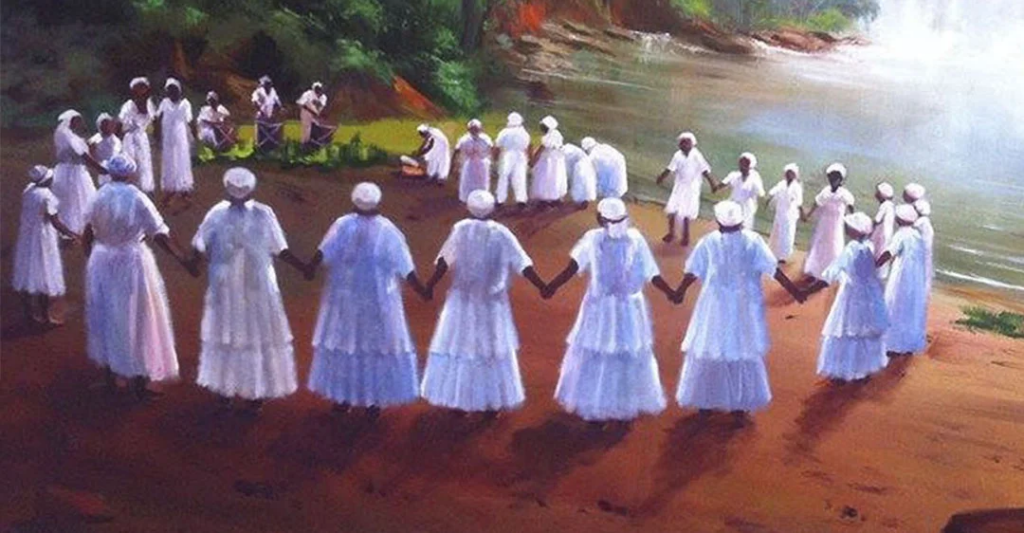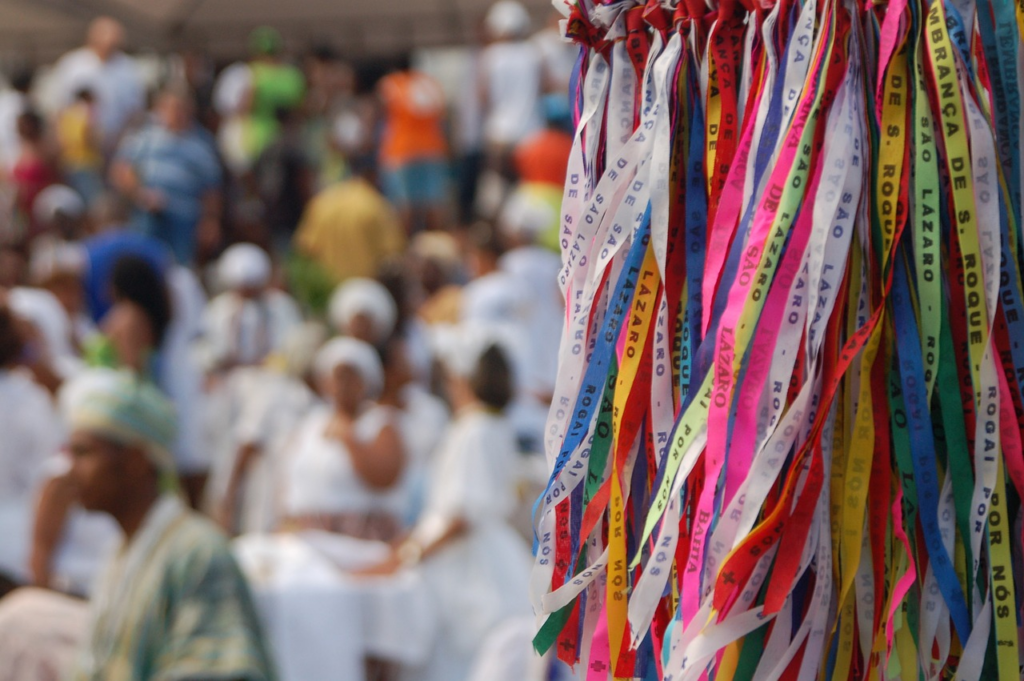African religions have a spiritual and cultural richness that fascinates and intrigues many people around the world. Two of the best known are Umbanda and Candomblé. Although they share African roots and similar elements, these two religions have their own distinct characteristics that make them unique. In this article, we'll explore the differences between Umbanda and Candomblé so that you can better understand these traditions.
Origins and History of Umbanda and Candomblé
Religions of African origin, such as Candomblé and Umbanda, play a significant role in the culture and spirituality of the Brazilian people. Their origins go back to the dark times of slavery and the resistance of the Africans brought to Brazil, who found in religiosity a way of preserving their identity and resisting oppression.
Candomblé
Candomblé has its roots in the spiritual traditions of the Yoruba people, from the region that is now Nigeria, and other African ethnic groups. During the period of the transatlantic slave trade, millions of Africans were brought to Brazil, where they were forced to work on the sugar cane plantations and in the mines. With them, they brought their beliefs, religious practices and systems of worship to the orixás.
In Brazil, slaves found ways to preserve their religious traditions, even under the pressure of slavery and colonial violence. Candomblé, therefore, is the result of this process of cultural and spiritual resistance. Enslaved Africans adapted their religious practices, often syncretizing them with elements of Catholicism to avoid persecution by the colonizers.
The first Candomblé terreiros were established in the urban and rural areas of northeastern Brazil, especially in Bahia, which became the center of Candomblé in the country. Over the years, Candomblé has spread to other regions of Brazil and continues to be a vital part of the cultural and spiritual identity of the Brazilian people.
Umbanda
Umbanda is a more recent religion, which emerged at the beginning of the 20th century in the urban context of Rio de Janeiro. Its origins are linked to the spiritual practices of Afro-Brazilian communities, especially those who lived in the city's favelas and suburbs.
Umbanda was influenced by a variety of religious traditions, including Candomblé, Kardecism (spiritism) and Catholicism. Its emergence can be seen as a response to Brazil's growing urbanization and the need for forms of spiritual expression that were more accessible and adaptable to city life.

The first Umbanda terreiros were established by mediums and spiritual leaders who sought to offer spiritual guidance, healing and consolation to people living on the margins of society. Umbanda quickly gained popularity among the working and marginalized classes of Rio de Janeiro and spread to other parts of Brazil.
Beliefs and Practices
Religious beliefs and practices play a fundamental role in people's spiritual and cultural lives, shaping their worldviews, behaviors and social relationships. In the context of African-based religions, such as Candomblé and Umbanda, beliefs and practices are intrinsically linked to the connection with the divine, reverence for ancestors and the search for spiritual guidance and healing.
Candomblé
In Candomblé, beliefs revolve around the cult of the orixás, which are deities that represent forces of nature, aspects of human life and cosmic elements. Each orixá has its own personality, characteristics, colors, symbols and domains. They are venerated and invoked in specific rituals, where food, drink, dances and songs are offered in their honor.
Candomblé rituals take place in terreiros, sacred spaces where the faithful gather to worship the orixás. The priests and priestesses, known as babalorixás and ialorixás, lead these rituals, which can include initiation ceremonies, seasonal festivals, spiritual consultations and healing work.
Candomblé practitioners believe in the existence of a link between the material world and the spiritual world, and that through rituals and offerings to the orixás it is possible to establish this connection and obtain divine guidance, protection and blessing.
Umbanda
In Umbanda, there is a fusion of African, indigenous and Christian beliefs, resulting in a syncretic religion that incorporates a wide variety of spiritual practices. As well as worshipping the orixás, Umbanda also reveres other spiritual entities, such as caboclos (indigenous spirits), pretos velhos (spirits of enslaved ancestors), exus and pombagiras (entities that deal with earthly issues) and erês (child spirits).
Umbanda rituals take place in terreiros, where mediums incorporate these spiritual entities during spiritual sessions. Umbanda work can include mediumistic development sessions, spiritual passes, consultations with spirit guides, healing work, the discharge of negative energies and charitable practices.
Umbanda emphasizes the principle of charity and assistance to those in need, and many terreiros carry out social and community activities to help those in vulnerable situations. In addition, Umbanda believes in spiritual evolution and personal growth through mediumistic development and the practice of charity.
Hierarchy and Organization
In both Candomblé and Umbanda, hierarchy and organization play a crucial role in structuring religious practices and transmitting spiritual traditions. Let's explore in more detail how this manifests itself in each of these religions:
Hierarchy and Organization in Candomblé
In Candomblé, the hierarchy is traditionally based on spiritual lineage and knowledge passed down from generation to generation. Each terreiro is led by a priest or priestess known as a babalorixá (pai de santo) or ialorixá (mãe de santo), who is responsible for conducting the rituals, guiding the faithful and preserving the religious traditions.
In addition to the spiritual leaders, Candomblé also has other important figures in the terreiro hierarchy, such as the ogãs (those responsible for the rhythms and musical instruments in the rituals), the ekedis (assistants to the ialorixás) and the filhos e filhas de santo, who are those initiated into the mysteries of the religion and dedicate themselves to serving the orixás.
The hierarchy in Candomblé reflects the importance of ancestry, the wisdom of the elders and respect for spiritual traditions, creating a structure that promotes the continuity and preservation of the religion over time.
Hierarchy and Organization in Umbanda
In Umbanda, the hierarchy and organization are more flexible and vary according to the traditions of each terreiro. As in Candomblé, there are spiritual leaders known as pais or mães de santo, who are responsible for guiding the faithful, conducting the rituals and maintaining order within the terreiro.
However, Umbanda can also be organized into different lines, which represent different spiritual traditions and forms of worship. Each line can have its own rituals, practices and internal hierarchy, reflecting the diversity within the religion.
In addition to the spiritual leaders, Umbanda also values the active participation of all members of the religious community, encouraging collaboration, the sharing of knowledge and solidarity among practitioners.
Religious syncretism
Religious syncretism is a defining characteristic of both Candomblé and Umbanda, and plays a significant role in the formation and evolution of these African-based religions in the Brazilian context. Let's explore in more detail what religious syncretism is and how it manifests itself in these traditions:
What is Religious Syncretism
Religious syncretism is a complex phenomenon that occurs when two or more religious traditions merge, resulting in the incorporation of elements from one religious tradition into another. This usually occurs in contexts where different ethnic, cultural or religious groups come into contact and interact with each other, leading to the exchange and mixing of beliefs, rituals, practices and symbols.

This process of syncretism can take many forms, from the association of deities from one religion with figures or saints from another, to the adaptation of rituals and ceremonies to incorporate elements from different traditions. The result is a unique synthesis of religious traditions that reflects the diversity and interconnectedness of human experiences.
In the Brazilian context, religious syncretism is especially evident due to the country's multicultural history, marked by European colonization, African slavery and indigenous presence. These different ethnic groups brought with them their own religious traditions, which have intertwined and influenced each other over time.
A classic example of religious syncretism in Brazil is the association of Candomblé orishas with Catholic saints. This practice allowed enslaved Africans to maintain their religious beliefs while appearing to adopt Catholicism, the dominant religion of the colonizers. Thus, deities such as Oxum were associated with Our Lady of the Conception, while Ogum was associated with St. George. This syncretism not only preserved African religious traditions, but also created a new spiritual expression that is unique to Brazil.
Moreover, religious syncretism is not limited to Candomblé. Other Brazilian religious traditions, such as Umbanda, also incorporate elements from different cultures and spiritual traditions, resulting in a rich diversity of religious practices in the country.
Syncretism in Candomblé
In Candomblé, syncretism is evident in the association of the orishas with Catholic saints, a strategy used by African slaves to preserve their religious beliefs without attracting the attention of the colonizers. For example, the orixá Oxalá is often associated with Jesus Christ, Oxum with Our Lady of the Conception, and Iemanjá with Our Lady of the Immaculate Conception. These associations reflect the practitioners' attempt to keep their African religious traditions secret, while appearing to adopt the Catholic religion imposed by the colonizers.
Syncretism in Umbanda
In Umbanda, syncretism is even more pronounced, as the religion incorporates a variety of cultural and religious influences. In addition to the orixás' associations with Catholic saints, Umbanda also includes the presence of other spiritual entities, such as caboclos, pretos velhos and exus, which reflect the ethnic and spiritual diversity of the Brazilian people. These entities are often associated with historical, mythological or religious figures from different cultures, resulting in a rich tapestry of spiritual syncretism.
Impact and Meaning
Religious syncretism has a profound and significant impact on the societies in which it occurs, influencing not only religious practices and beliefs, but also the cultural, social and political identity of the communities involved. Let's explore the impact and significance of religious syncretism in more detail:
Cultural Preservation and Resistance
One of the most important impacts of religious syncretism is the cultural preservation and resistance of ethnic minority groups in the face of cultural and religious domination. In contexts of colonization or slavery, syncretism allowed colonized or enslaved peoples to maintain their beliefs, traditions and cultural identities, even under pressure to assimilate to the dominant culture.
In Brazil, for example, religious syncretism allowed enslaved Africans to preserve their religious traditions, adapting and mixing them with elements of the Catholicism imposed by the colonizers. This not only provided a sense of cultural continuity for the enslaved, but also allowed them to express their spirituality in a clandestine way, often performing their rituals in secret in Candomblé terreiros.
Creating a National and Cultural Identity
Religious syncretism also plays a role in shaping a society's national and cultural identity. In contexts where different ethnic groups coexist, religious syncretism can serve as a means of uniting these groups under a common identity, creating a unique synthesis of beliefs and practices that reflects the country's cultural diversity.
In Brazil, for example, religious syncretism has contributed to the formation of a national identity that is characterized by ethnic, cultural and religious diversity. Syncretism has not only created a new spiritual expression that is unique to the country, but has also influenced other spheres of Brazilian culture, such as music, dance, cuisine and the arts.
Promoting Religious Tolerance
Religious syncretism can also promote religious tolerance and interfaith dialogue by recognizing and respecting the diversity of beliefs and spiritual practices. By emphasizing the similarities between different religious traditions and recognizing that they all have something to contribute to the understanding of the divine, syncretism can serve as a catalyst for harmony and mutual respect between different religious communities.
Similar elements, different religions
Although Umbanda and Candomblé share African roots and similar elements, they are distinct religions with their own beliefs, practices and traditions. While Candomblé is more focused on the cult of the orixás and maintains a closer link with its African origins, Umbanda is a more eclectic religion that incorporates a variety of cultural and spiritual influences.
Regardless of the differences, both Umbanda and Candomblé play an important role in the spiritual and cultural life of the Brazilian people, offering comfort, guidance and connection with the divine to millions of people across the country.
See also: Who was St. Jude Thaddeus, the protector of Flamengo?
April 3rd, 2024

She has a degree in Literature - Portuguese/English, and is the creator of the Escritora de Sucesso website. As a writer, she seeks to expand everyone's knowledge with relevant information on various subjects. At Trend-Topics, she brings news and content ranging from entertainment to the country's economic situation.






